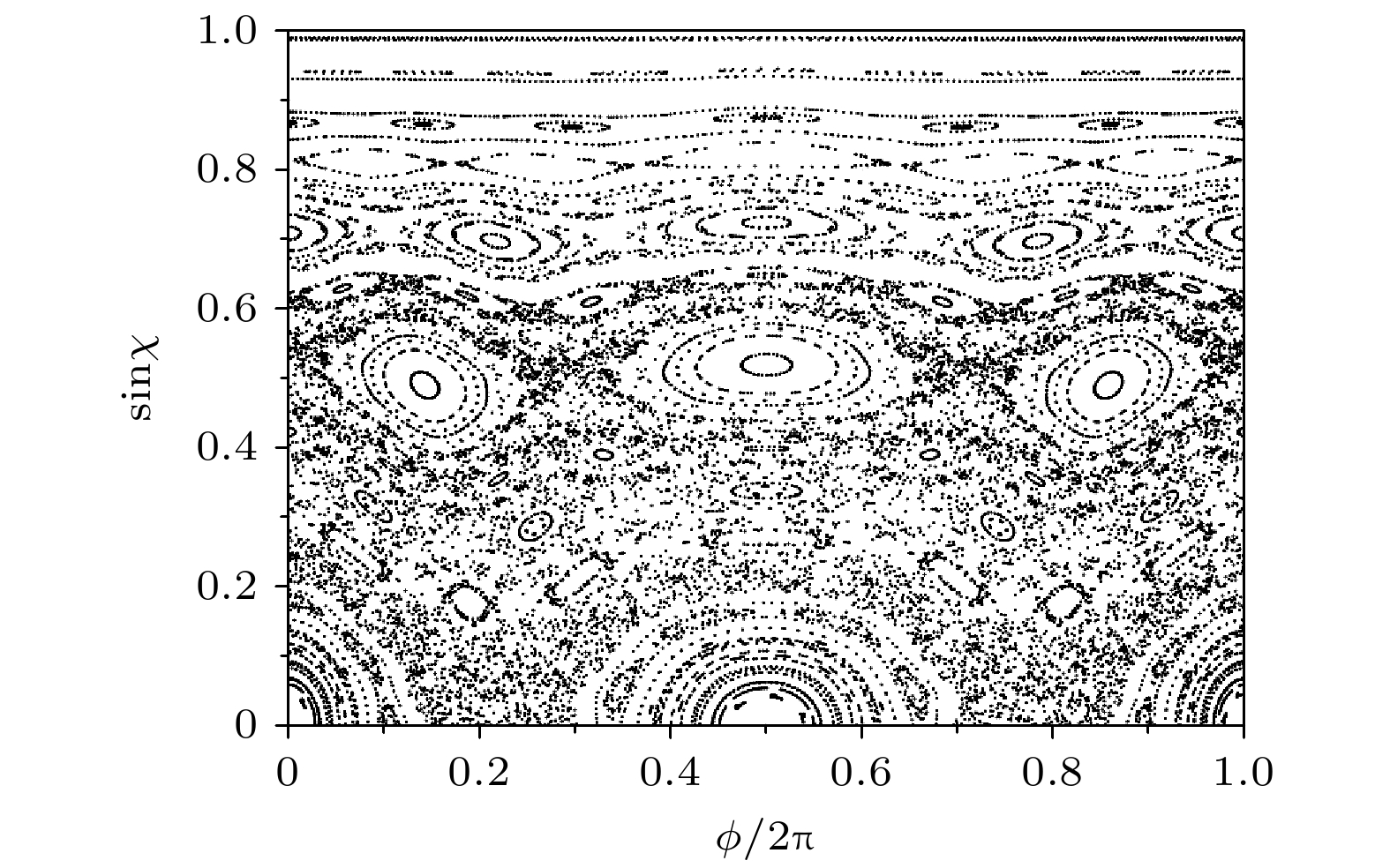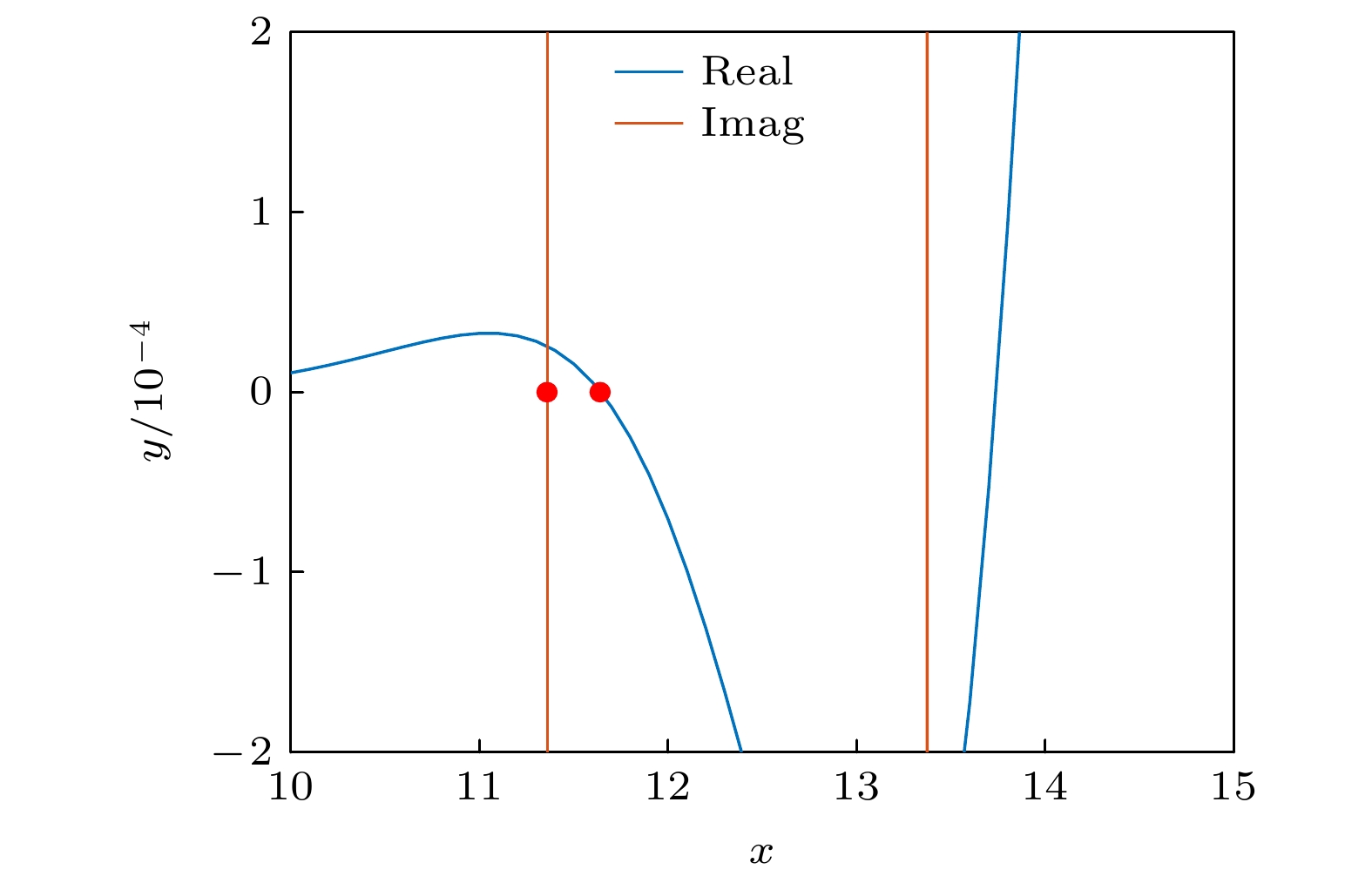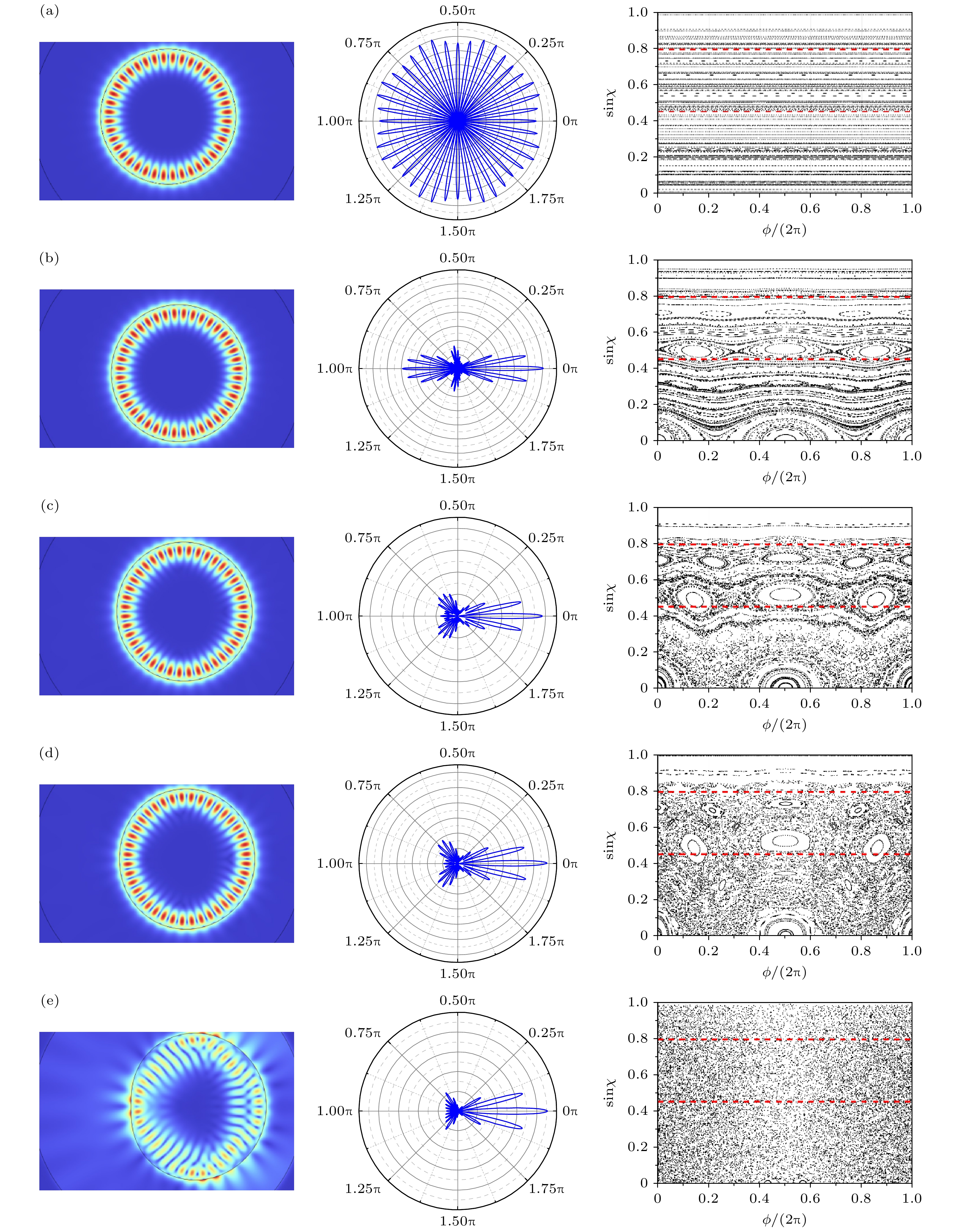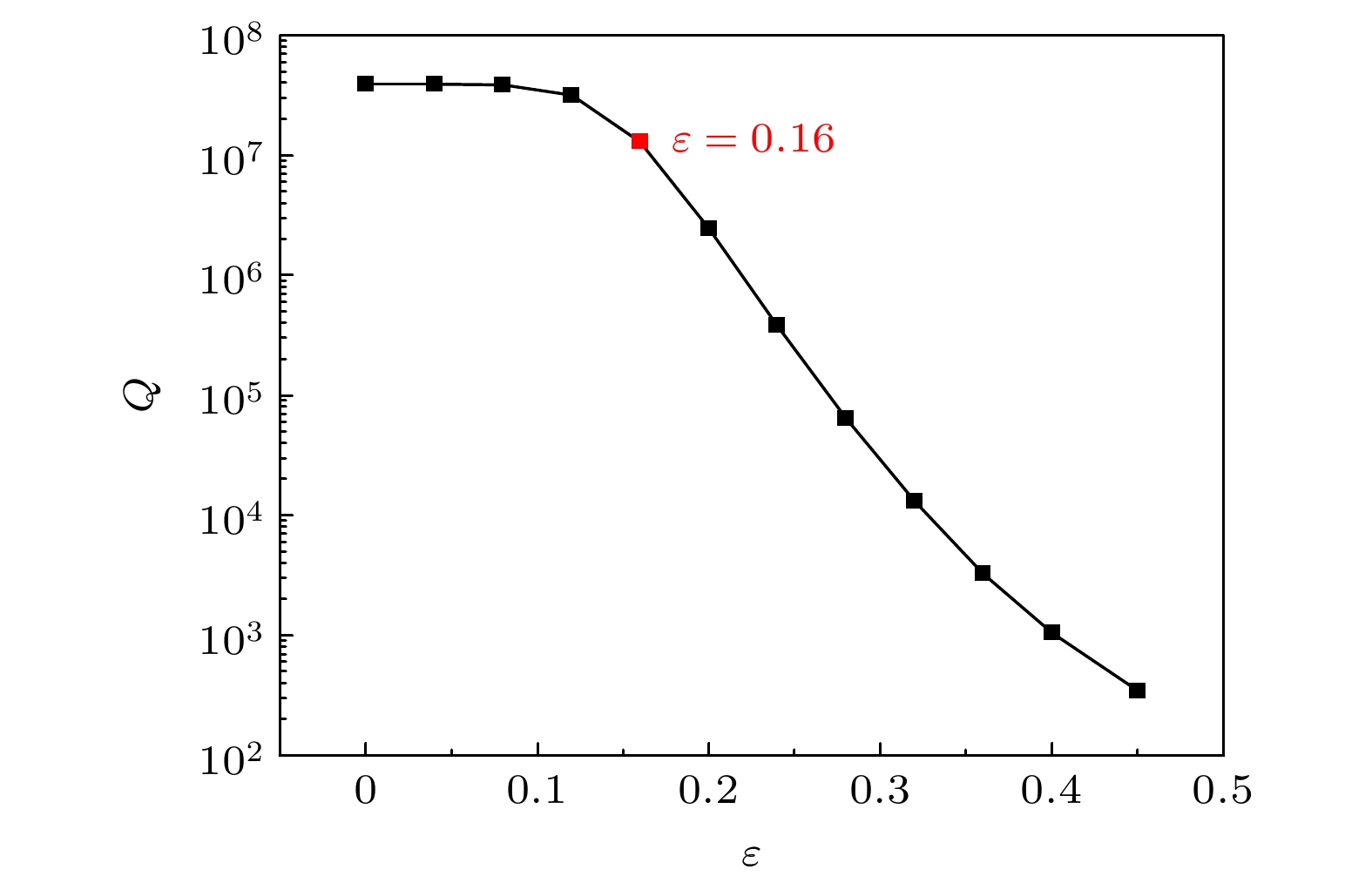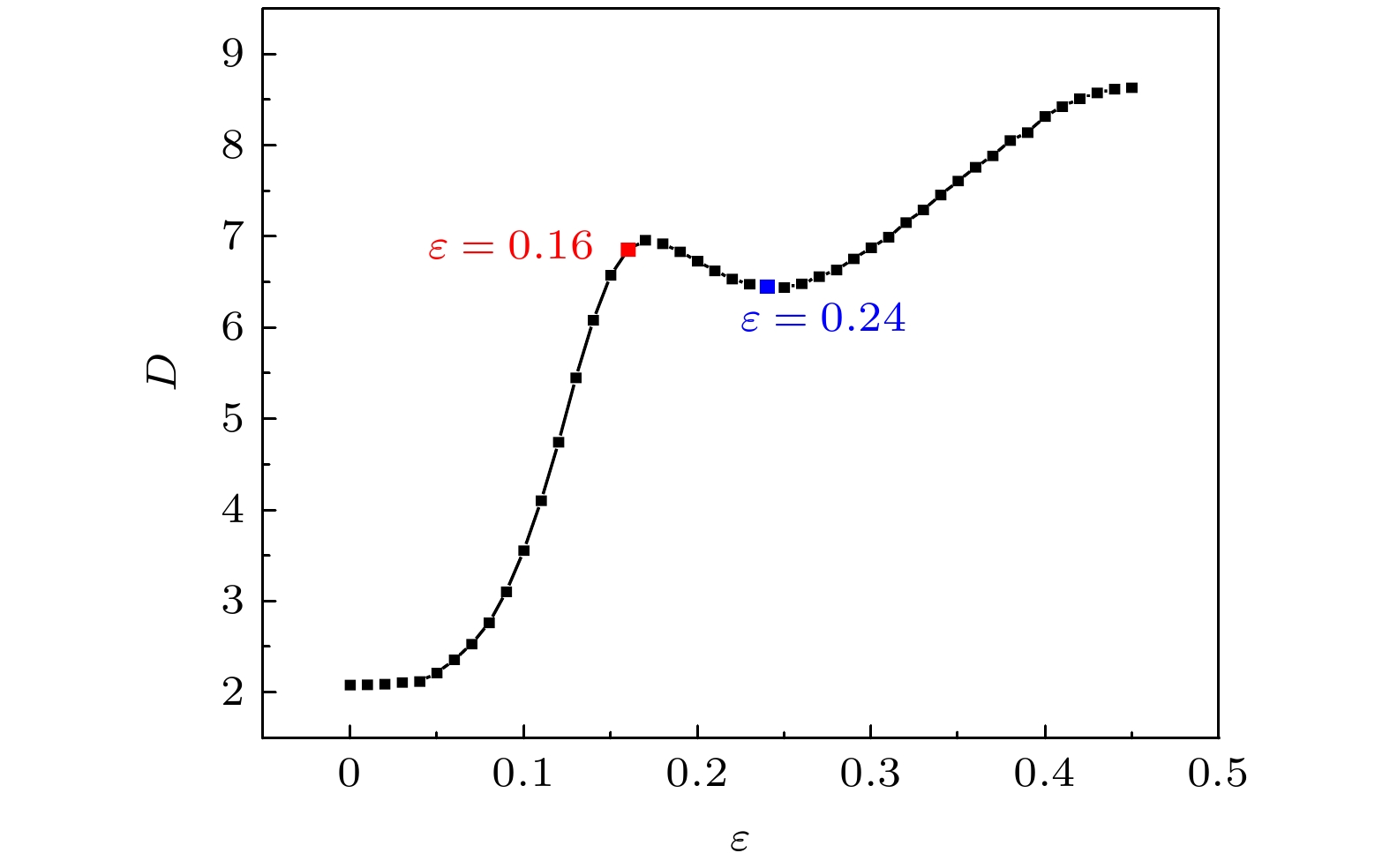-
基于半导体变形微腔的定向激射效应, 在各向同性薄膜中制备变形微腔, 将为多功能、高集成光子有源芯片提供新的解决方案. 利用二维波动光学理论, 以Z切向掺饵铌酸锂薄膜蚶线形微盘中的TE20,1模式为例, 分析了不同变形因子
$\varepsilon $ 微盘的模式分布、品质因子Q、定向激射效果D以及庞加莱截面图. 理论模拟结果显示, 微盘变形过程中微盘周长与谐振波长的比值近似为一定值. 当$\varepsilon $ 大于0.24时, 微盘具有较好的单向激射性, Q值大于105; 当$\varepsilon $ 变形因子大于0.4时, 庞加莱截面图几乎被混沌海区域占据, Q值低于103. 因此, 薄膜蚶线形微盘变形因子$\varepsilon $ 在0.24—0.4之间时, 微盘不仅具有高的品质因子(Q值为103—105), 激射方向性也较高(D值为6.45—8.32).Based on the directional emission effect of semiconductor deformed microcavities, the fabrication of deformed microcavities in isotropic thin films will provide a new solution for multifunctional and highly integrated photonic active chips. Because the Limacon shaped microcavity has become one of the important configurations of single-mode, low threshold on-chip lasers, the directional emission properties of microdisks fabricated in thin film are investigated. Taking the TE20,1 mode existing in the Z-cut lithium niobate thin film microdisk for example, according to two-dimensional wave optics theory, the mode distribution, quality factor Q, and directional emission factor D of microdisk variations with deformation factor$\varepsilon $ are respectively analyzed through using the wave optics module of COMSOL. Adopting classical scattering theory, Poincaré surfaces of sections under different deformation factors are simulated by optimizing the Dynamical Billards.jl library in Julia. In the simulation realized by Julia, 200 particle collisions are used 200 times to simulate 200 reflections of rays and finally PSOS images are obtained. Simulation results reveal that when the azimuthal quantum number of the light wave mode remains unchanged, although the shape of the microdisk varies, the ratio of the resonant wavelength inside the microdisk to the circumference of the microdisk is approximately a constant, which can predict the microdisk size and resonant wavelength estimation of microcavities. The corresponding PSOS shows that when$\varepsilon > 0.45$ , the entire region is covered by chaotic sea area, therefore$\varepsilon $ values of 0, 0.16, 0.24, 0.28, 0.45 are selected to simulate the TE20,1 mode distribution, far-field radiation flux angle distribution, and PSOS. Theoretical simulation results show that when the deformation factor is greater than 0.24, the microdisk has good unidirectional lasing property, with a Q factor greater than 105. When the deformation factor is greater than 0.4, the PSOS is almost occupied by the chaotic sea area, with a Q factor below 103. Therefore, when the deformation factor of the limacon microdisk in the thin film can be chosen between 0.24 and 0.4, under which circumstance the microdisk not only carries high quality factor (about 103–105), but also forms high laser directionality (about 6.45–8.32). The theoretical simulation results will provide a certain theoretical reference for conducting the experimental research of thin film deformation microcavities.-
Keywords:
- limacon microdisk /
- mode distribution /
- Q factor /
- directional emission
[1] Baaske M D, Foreman M R, Vollmer F 2014 Nat. Nanotechnol. 9 933
 Google Scholar
Google Scholar
[2] Kippenberg T J, Holzwarth R, Diddams S A 2011 Science 332 555
 Google Scholar
Google Scholar
[3] Kippenberg T J, Vahala K J 2008 Science 321 1172
 Google Scholar
Google Scholar
[4] Michael C P, Srinivasan K, Johnson T J, Painter O, Lee K H, Hennessy K, Kim H, Hu E 2007 Appl. Phys. Lett. 90 051108
 Google Scholar
Google Scholar
[5] Redding B, Ge L, Song Q H, Wiersig J, Solomon G S, Cao H 2012 Phys. Rev. Lett. 108 253902
 Google Scholar
Google Scholar
[6] Fang W, Cao H, Solomon G S 2007 Appl. Phys. Lett. 90 081108
 Google Scholar
Google Scholar
[7] Unterhinninghofen J, Wiersig J, Hentschel M 2008 Phys. Rev. E 78 016201
 Google Scholar
Google Scholar
[8] Michler P, Kiraz A, Becher C, Schoenfeld W V, Petroff P M, Zhang L, Hu E, Imamoglu A 2000 Science 290 2282
 Google Scholar
Google Scholar
[9] Jiang X F, Zou C L, Wang L, Gong Q H, Xiao Y F 2016 Laser Photonics Rev. 10 40
 Google Scholar
Google Scholar
[10] Chern G D, Tureci H E, Stone A D, Chang R K, Kneissl M, Johnson N M 2003 Appl. Phys. Lett. 83 1710
 Google Scholar
Google Scholar
[11] Kurdoglyan M S, Lee S Y, Rim S, Kim C M 2004 Opt. Lett. 29 2758
 Google Scholar
Google Scholar
[12] Baryshnikov Y, Heider P, Parz W, Zharnitsky V 2004 Phys. Rev. Lett. 93 133902
 Google Scholar
Google Scholar
[13] Gao J, Heider P, Chen C J, Yang X D, Husko C A, Wong C W 2007 Appl. Phys. Lett. 91 181101
 Google Scholar
Google Scholar
[14] Wiersig J, Hentschel M 2006 Phys. Rev. A 73 031802
 Google Scholar
Google Scholar
[15] Fang W, Yamilov A, Cao H 2005 Phys. Rev. A 72 023815
 Google Scholar
Google Scholar
[16] Lee S Y, Kurdoglyan M S, Rim S, Kim C M 2004 Phys. Rev. A 70 023809
 Google Scholar
Google Scholar
[17] Lebental M, Lauret J S, Hierle R, Zyss J 2006 Appl. Phys. Lett. 88 031108
 Google Scholar
Google Scholar
[18] Wiersig J, Hentschel M 2008 Phys. Rev. Lett. 100 033901
 Google Scholar
Google Scholar
[19] Yi C H, Kim M W, Kim C M 2009 Appl. Phys. Lett. 95 141107
 Google Scholar
Google Scholar
[20] Song Q H, Fang W, Liu B Y, Ho S T, Solomon G S, Cao H 2009 Phys. Rev. A 80 041807
 Google Scholar
Google Scholar
[21] Kim K, Bittner S, Jin Y H, Zeng Y Q, Wang Q J, Cao H 2023 Opt. Lett. 48 574
 Google Scholar
Google Scholar
[22] Yan C L, Shi J W, Li P, Li H, Zhang J J 2014 Opt. Laser Technol. 56 285
 Google Scholar
Google Scholar
[23] Fang Z W, Haque S, Farajollahi S, Luo H P, Lin J, Wu R B, Zhang J H, Wang Z, Wang M, Cheng Y, Lu T 2020 Phys. Rev. Lett. 125 173901
 Google Scholar
Google Scholar
[24] Lin J T, Farajollahi S, Fang Z W, Yao N, Gao R H, Guan J L, Deng L, Lu T, Wang M, Zhang H S, Fang W, Qiao L L, Cheng Y 2022 Adv. Photonics 4 036001
 Google Scholar
Google Scholar
[25] Foreman M R, Vollmer F 2013 New J. Phys. 15 083006
 Google Scholar
Google Scholar
[26] Swaim J D, Knittel J, Bowen W P 2011 Appl. Phys. Lett. 99 243109
 Google Scholar
Google Scholar
[27] Lee J, Rim S, Cho J, Kim C M 2008 Phys. Rev. Lett. 101 064101
 Google Scholar
Google Scholar
[28] Farajollahi S, Fang Z W, Lin J T, Honari S, Cheng Y, Lu T 2023 Phys. Rev. A 108 033520
 Google Scholar
Google Scholar
[29] Cao H, Wiersig J 2015 Rev. Mod. Phys. 87 61
 Google Scholar
Google Scholar
[30] Ryu J W, Rim S, Park Y J, Kim C M, Lee S Y 2008 Phys. Lett. A 372 3531
 Google Scholar
Google Scholar
[31] 邹长铃, 董春华, 崔金明, 孙方稳, 杨勇, 吴晓伟, 韩正甫,郭光灿 2012 中国科学: 物理学 力学 天文学 42 1155
Zou C L, Dong C H, Cui J M, Sun F W, Yang Y, Wu X W, Han Z F, Guo G C 2012 Sci. Sin. Phys. Mech. Astron. 42 1155
[32] Qi J W, Yan C L, Diehl L, Hentschel M, Wiersig J, Yu N F, Pflügl C, Belkin M A, Edamura T, Yamanishi M, Kan H, Capasso F 2009 New J. Phys. 11 125018
 Google Scholar
Google Scholar
[33] Li J C, Huang Y T, Hao Y Z, Yang Y D, Xiao J L 2022 Single-mode Lasing Deformed Square Microcavity Lasers (USA: SPIE) p125011I
[34] Wu R, Zhang J, Yao N, Fang W, Qiao L, Chai Z, Lin J, Cheng Y 2018 Opt. Lett. 43 4116
 Google Scholar
Google Scholar
[35] Ilchenko V S, Savchenkov A A, Matsko A B, Maleki L 2004 Phys. Rev. Lett. 92 043903
 Google Scholar
Google Scholar
[36] Pan Y, Lin G, Diallo S, Zhang X, Chembo Y K 2017 IEEE Photonics J. 9 1
 Google Scholar
Google Scholar
[37] Wang L, Wang C, Wang J, Bo F, Zhang M, Gong Q, Loncar M, Xiao Y F 2018 Opt. Lett. 43 2917
 Google Scholar
Google Scholar
[38] Gao A, Yang C, Chen L K, Zhang R, Luo Q, Wang W, Cao Q T, Hao Z Z, Bo F, Zhang G Q, Xu J J 2022 Photonics Res. 10 401
 Google Scholar
Google Scholar
[39] Zhu D, Shao L B, Yu M J, Cheng R, Desiatov B, Xin C J, Hu Y W, Holzgrafe J, Ghosh S, Shams-Ansari A, Puma E, Sinclair N, Reimer C, Zhang M, Lončar M 2021 Adv. Opt. Photonics 13 242
 Google Scholar
Google Scholar
[40] Gopalan V, Dierolf V, Scrymgeour D A 2007 Annu. Rev. Mater. Res. 37 449
 Google Scholar
Google Scholar
[41] Sanna S, Schmidt W G 2010 Phys. Rev. B 81 214116
 Google Scholar
Google Scholar
[42] Xiao Y F, Zou C L, Li Y, Dong C H, Han Z F, Gong Q H 2010 Front. Optoelectron. 3 109
 Google Scholar
Google Scholar
[43] Yang Q F, Jiang X F, Cui Y L, Shao L B, Xiao Y F 2013 Phys. Rev. A 88 023810
 Google Scholar
Google Scholar
[44] Jiang X F, Shao L B, Zhang S X, Yi X, Wiersig J, Wang L, Gong Q H, Loncar M, Yang L, Xiao Y F 2017 Science 358 344
 Google Scholar
Google Scholar
[45] Xiao Y F, Jiang X F, Yang Q F, Wang L, Shi K B, Li Y, Gong Q H 2013 Laser Photonics Rev. 7 L51
 Google Scholar
Google Scholar
[46] Boriskina S V, Benson T M, Sewell P, Nosich A I 2006 IEEE J. Sel. Top. Quantum Electron. 12 52
 Google Scholar
Google Scholar
[47] Boriskina S V, Sewell P, Benson T M, Nosich A I 2004 J. Opt. Soc. Am. A 21 393
 Google Scholar
Google Scholar
[48] Zelmon D E, Small D L, Jundt D 1997 J. Opt. Soc. Am. B 14 3319
 Google Scholar
Google Scholar
-
图 5 TE20, 1模式分布 (a) 微盘周长${L_\varepsilon }$与变形因子$\varepsilon $间的关系; (b) 谐振波长${\lambda _\varepsilon }$与变形因子$\varepsilon $间的关系; (c) 谐振波长${\lambda _\varepsilon }$与微盘周长${L_\varepsilon }$间存在线性变化关系
Fig. 5. Under the TE20, 1 mode: (a) resonant wavelength $ {\lambda }_{\varepsilon } $ variation with $\varepsilon $; (b) microdisk’s perimeter ${L_\varepsilon }$ variation with $\varepsilon $; (c) resonant wavelength $ {\lambda }_{\varepsilon } $ variation with perimeter ${L_\varepsilon }$ and linear fitting.
图 8 $\varepsilon $分别为0.16, 0.18, 0.20, 0.22, 0.24时, 以$S{\left( \varphi \right)_{{\text{max}}}}$归一化的 (a)全局远场辐射通量$S\left( \varphi \right)$角分布图, (b)角度在$90^\circ $—$270^\circ $之间的远场辐射通量$S\left( \varphi \right)$的角分布图
Fig. 8. (a) Global far-field radiation flux angular distribution diagram; (b) the angular distribution of far-field radiation flux at angles between $90^\circ $ and $270^\circ $, with the deformation factor $\varepsilon $ taken as 0.16, 0.18, 0.20, 0.22, 0.24, according to the normalization of $S{\left( \varphi \right)_{{\text{max}}}}$.
表 1 不同$\varepsilon $的最大远场辐射通量密度$S{\left( \varphi \right)_{{\text{max}}}}$对应的定向角$\varphi $
Table 1. $S{\left( \varphi \right)_{{\text{max}}}}$ and $\varphi $ with different $\varepsilon $.
变形因子$\varepsilon $ 最大远场辐射通量密度$S{\left( \varphi \right)_{{\text{max}}}}/({\text{W}}{\cdot} {{\text{m}}^{ - 2}})$ 定向角$\varphi /(^\circ )$ 0 $6.06 \times {10^1}$ 17.98 0.04 $6.18 \times {10^1}$ 179.75 0.08 $8.20 \times {10^1}$ 180.25 0.12 $1.71 \times {10^2}$ 0 0.16 $6.06 \times {10^2}$ 0 0.20 $3.13 \times {10^3}$ 0 0.24 $1.93 \times {10^4}$ 0 0.28 $1.17 \times {10^5}$ 0.50 0.32 $6.24 \times {10^5}$ 0 0.36 $2.63 \times {10^6}$ 359.00 0.40 $8.30 \times {10^6}$ 0 0.45 $2.27 \times {10^7}$ 0 -
[1] Baaske M D, Foreman M R, Vollmer F 2014 Nat. Nanotechnol. 9 933
 Google Scholar
Google Scholar
[2] Kippenberg T J, Holzwarth R, Diddams S A 2011 Science 332 555
 Google Scholar
Google Scholar
[3] Kippenberg T J, Vahala K J 2008 Science 321 1172
 Google Scholar
Google Scholar
[4] Michael C P, Srinivasan K, Johnson T J, Painter O, Lee K H, Hennessy K, Kim H, Hu E 2007 Appl. Phys. Lett. 90 051108
 Google Scholar
Google Scholar
[5] Redding B, Ge L, Song Q H, Wiersig J, Solomon G S, Cao H 2012 Phys. Rev. Lett. 108 253902
 Google Scholar
Google Scholar
[6] Fang W, Cao H, Solomon G S 2007 Appl. Phys. Lett. 90 081108
 Google Scholar
Google Scholar
[7] Unterhinninghofen J, Wiersig J, Hentschel M 2008 Phys. Rev. E 78 016201
 Google Scholar
Google Scholar
[8] Michler P, Kiraz A, Becher C, Schoenfeld W V, Petroff P M, Zhang L, Hu E, Imamoglu A 2000 Science 290 2282
 Google Scholar
Google Scholar
[9] Jiang X F, Zou C L, Wang L, Gong Q H, Xiao Y F 2016 Laser Photonics Rev. 10 40
 Google Scholar
Google Scholar
[10] Chern G D, Tureci H E, Stone A D, Chang R K, Kneissl M, Johnson N M 2003 Appl. Phys. Lett. 83 1710
 Google Scholar
Google Scholar
[11] Kurdoglyan M S, Lee S Y, Rim S, Kim C M 2004 Opt. Lett. 29 2758
 Google Scholar
Google Scholar
[12] Baryshnikov Y, Heider P, Parz W, Zharnitsky V 2004 Phys. Rev. Lett. 93 133902
 Google Scholar
Google Scholar
[13] Gao J, Heider P, Chen C J, Yang X D, Husko C A, Wong C W 2007 Appl. Phys. Lett. 91 181101
 Google Scholar
Google Scholar
[14] Wiersig J, Hentschel M 2006 Phys. Rev. A 73 031802
 Google Scholar
Google Scholar
[15] Fang W, Yamilov A, Cao H 2005 Phys. Rev. A 72 023815
 Google Scholar
Google Scholar
[16] Lee S Y, Kurdoglyan M S, Rim S, Kim C M 2004 Phys. Rev. A 70 023809
 Google Scholar
Google Scholar
[17] Lebental M, Lauret J S, Hierle R, Zyss J 2006 Appl. Phys. Lett. 88 031108
 Google Scholar
Google Scholar
[18] Wiersig J, Hentschel M 2008 Phys. Rev. Lett. 100 033901
 Google Scholar
Google Scholar
[19] Yi C H, Kim M W, Kim C M 2009 Appl. Phys. Lett. 95 141107
 Google Scholar
Google Scholar
[20] Song Q H, Fang W, Liu B Y, Ho S T, Solomon G S, Cao H 2009 Phys. Rev. A 80 041807
 Google Scholar
Google Scholar
[21] Kim K, Bittner S, Jin Y H, Zeng Y Q, Wang Q J, Cao H 2023 Opt. Lett. 48 574
 Google Scholar
Google Scholar
[22] Yan C L, Shi J W, Li P, Li H, Zhang J J 2014 Opt. Laser Technol. 56 285
 Google Scholar
Google Scholar
[23] Fang Z W, Haque S, Farajollahi S, Luo H P, Lin J, Wu R B, Zhang J H, Wang Z, Wang M, Cheng Y, Lu T 2020 Phys. Rev. Lett. 125 173901
 Google Scholar
Google Scholar
[24] Lin J T, Farajollahi S, Fang Z W, Yao N, Gao R H, Guan J L, Deng L, Lu T, Wang M, Zhang H S, Fang W, Qiao L L, Cheng Y 2022 Adv. Photonics 4 036001
 Google Scholar
Google Scholar
[25] Foreman M R, Vollmer F 2013 New J. Phys. 15 083006
 Google Scholar
Google Scholar
[26] Swaim J D, Knittel J, Bowen W P 2011 Appl. Phys. Lett. 99 243109
 Google Scholar
Google Scholar
[27] Lee J, Rim S, Cho J, Kim C M 2008 Phys. Rev. Lett. 101 064101
 Google Scholar
Google Scholar
[28] Farajollahi S, Fang Z W, Lin J T, Honari S, Cheng Y, Lu T 2023 Phys. Rev. A 108 033520
 Google Scholar
Google Scholar
[29] Cao H, Wiersig J 2015 Rev. Mod. Phys. 87 61
 Google Scholar
Google Scholar
[30] Ryu J W, Rim S, Park Y J, Kim C M, Lee S Y 2008 Phys. Lett. A 372 3531
 Google Scholar
Google Scholar
[31] 邹长铃, 董春华, 崔金明, 孙方稳, 杨勇, 吴晓伟, 韩正甫,郭光灿 2012 中国科学: 物理学 力学 天文学 42 1155
Zou C L, Dong C H, Cui J M, Sun F W, Yang Y, Wu X W, Han Z F, Guo G C 2012 Sci. Sin. Phys. Mech. Astron. 42 1155
[32] Qi J W, Yan C L, Diehl L, Hentschel M, Wiersig J, Yu N F, Pflügl C, Belkin M A, Edamura T, Yamanishi M, Kan H, Capasso F 2009 New J. Phys. 11 125018
 Google Scholar
Google Scholar
[33] Li J C, Huang Y T, Hao Y Z, Yang Y D, Xiao J L 2022 Single-mode Lasing Deformed Square Microcavity Lasers (USA: SPIE) p125011I
[34] Wu R, Zhang J, Yao N, Fang W, Qiao L, Chai Z, Lin J, Cheng Y 2018 Opt. Lett. 43 4116
 Google Scholar
Google Scholar
[35] Ilchenko V S, Savchenkov A A, Matsko A B, Maleki L 2004 Phys. Rev. Lett. 92 043903
 Google Scholar
Google Scholar
[36] Pan Y, Lin G, Diallo S, Zhang X, Chembo Y K 2017 IEEE Photonics J. 9 1
 Google Scholar
Google Scholar
[37] Wang L, Wang C, Wang J, Bo F, Zhang M, Gong Q, Loncar M, Xiao Y F 2018 Opt. Lett. 43 2917
 Google Scholar
Google Scholar
[38] Gao A, Yang C, Chen L K, Zhang R, Luo Q, Wang W, Cao Q T, Hao Z Z, Bo F, Zhang G Q, Xu J J 2022 Photonics Res. 10 401
 Google Scholar
Google Scholar
[39] Zhu D, Shao L B, Yu M J, Cheng R, Desiatov B, Xin C J, Hu Y W, Holzgrafe J, Ghosh S, Shams-Ansari A, Puma E, Sinclair N, Reimer C, Zhang M, Lončar M 2021 Adv. Opt. Photonics 13 242
 Google Scholar
Google Scholar
[40] Gopalan V, Dierolf V, Scrymgeour D A 2007 Annu. Rev. Mater. Res. 37 449
 Google Scholar
Google Scholar
[41] Sanna S, Schmidt W G 2010 Phys. Rev. B 81 214116
 Google Scholar
Google Scholar
[42] Xiao Y F, Zou C L, Li Y, Dong C H, Han Z F, Gong Q H 2010 Front. Optoelectron. 3 109
 Google Scholar
Google Scholar
[43] Yang Q F, Jiang X F, Cui Y L, Shao L B, Xiao Y F 2013 Phys. Rev. A 88 023810
 Google Scholar
Google Scholar
[44] Jiang X F, Shao L B, Zhang S X, Yi X, Wiersig J, Wang L, Gong Q H, Loncar M, Yang L, Xiao Y F 2017 Science 358 344
 Google Scholar
Google Scholar
[45] Xiao Y F, Jiang X F, Yang Q F, Wang L, Shi K B, Li Y, Gong Q H 2013 Laser Photonics Rev. 7 L51
 Google Scholar
Google Scholar
[46] Boriskina S V, Benson T M, Sewell P, Nosich A I 2006 IEEE J. Sel. Top. Quantum Electron. 12 52
 Google Scholar
Google Scholar
[47] Boriskina S V, Sewell P, Benson T M, Nosich A I 2004 J. Opt. Soc. Am. A 21 393
 Google Scholar
Google Scholar
[48] Zelmon D E, Small D L, Jundt D 1997 J. Opt. Soc. Am. B 14 3319
 Google Scholar
Google Scholar
计量
- 文章访问数: 4645
- PDF下载量: 62
- 被引次数: 0

















 下载:
下载:
